Genghis Khan
Genghis Khan (born Temüjin; c. 1162 – 25 August 1227), also known as Chinggis Khan,[lower-alpha 1] was the founder and first khagan of the Mongol Empire, which later became the largest contiguous land empire in history. Having spent the majority of his life uniting the various Mongol tribes, he launched a series of military campaigns, conquering large parts of China and Central Asia.
| Genghis Khan | |||||||||||||
|---|---|---|---|---|---|---|---|---|---|---|---|---|---|
 Portrayal of Genghis Khan in a 14th-century Yuan-era album, originally painted in 1278 (National Palace Museum, Taipei) | |||||||||||||
| Khagan of the Mongol Empire | |||||||||||||
| Reign | Spring 1206 – 25 August 1227 | ||||||||||||
| Successor | Tolui (as regent) Ögedei Khan | ||||||||||||
| Born | Temüjin c. 1162 Khentii Mountains | ||||||||||||
| Died | 25 August 1227 (aged 64–65)[1] Xingqing, Western Xia | ||||||||||||
| Burial | |||||||||||||
| Spouse | |||||||||||||
| Issue |
| ||||||||||||
| |||||||||||||
| Dynasty | Borjigin | ||||||||||||
| Father | Yesügei | ||||||||||||
| Mother | Hö'elün | ||||||||||||
| Religion | Tengrism | ||||||||||||
| ||
|---|---|---|
|
Tribal campaigns
|
||
Born between 1155 and 1167 and given the name Temüjin, he was the oldest child of Yesugei, a Mongol chieftain of the Borjigin clan, and his wife Hö'elün of the Olkhonud clan. Yesugei died when Temüjin was eight, and his family was abandoned by their tribe in the Mongol steppe. Temüjin gradually built up a small following and allied with Jamukha and Toghrul, two other Mongol chieftains, in campaigns against other Mongol tribes. Due to the erratic nature of the sources, this period of Temüjin's life is uncertain; he may have spent this time as a servant of the Jin dynasty. The alliances with Jamukha and Toghrul failed completely in the early 13th century, but Temüjin was able to defeat both individuals and claim sole rulership over the Mongol tribes. He formally adopted the title "Genghis Khan" at a kurultai in 1206.
With the tribes fully united, Genghis set out on a campaign of conquest. Having vassalised the Western Xia state by 1211, he then invaded the Jin dynasty in northern China, forcing the Jin emperor Xuanzong to abandon the northern half of his realm in 1214. In 1218, Qara Khitai, a Central Asian khanate, was annexed by Mongol forces, allowing Genghis to lead an invasion of the neighbouring Khwarazmian Empire in the following year. The invading Mongols toppled the Khwarazmian state and devastated the regions of Transoxiana and Khorasan, while another expedition penetrated as far as Georgia and Kievan Rus'. In 1227, Genghis died while besieging the rebellious Western Xia; his third son and heir Ögedei succeeded him to the throne two years later.
The Mongol military campaigns begun by Genghis saw widespread destruction and millions of deaths across Asia and Eastern Europe. The Mongol army that he built was renowned for flexibility, discipline, and organisation, while his empire established itself upon meritocratic principles. He is revered and honoured in present-day Mongolia as a symbol of national identity and a central figure of Mongolian culture.
Name and title
There is no universally adopted system of transliterating original Mongolian names into English; many different systems and standards continue to be in use today, resulting in modern spellings that often differ considerably from the original pronunciation.[2] Ultimately, the honorific most commonly spelt Genghis derives from the autochthonous Mongolian ᠴᠢᠩᠭᠢᠰ ᠬᠠᠭᠠᠨ (Mongolian pronunciation: [t͡ʃʰiŋɡɪs xaːŋ]), which can be transliterated in English as Činggis. From this origin derived the Chinese 成吉思汗; Chéngjísī Hán and the Persian: چنگیز خان; Čəngīz H̱ān. As Arabic lacks a sound similar to "č", writers using the language transliterated the name to J̌ingiz, while Syriac writers used Šīngīz.[3] In modern English, common spellings include Chinggis, Chingis, Jinghis, and Jengiz, in addition to the dominant Genghis, which was introduced into English by 18th-century scholars who misread Persian sources.[4] His birth name ᠲᠡᠮᠦᠵᠢᠨ (Chinese: 鐵木真; Mongolian pronunciation: [tʰemut͡ʃiŋ]) is most commonly spelt Temüjin in English, although Temuchin is also sometimes used.[5]
When Genghis' grandson Kublai Khan established the Yuan dynasty in 1271, he bestowed the temple name Taizu (太祖, meaning "Supreme Progenitor") and the posthumous name Shengwu huangdi (Chinese: 聖武皇帝, meaning "Holy-Martial Emperor") upon his grandfather. Kublai's great-grandson Külüg Khan later expanded this title into Fatian Qiyun Shengwu Huangdi (法天啟運聖武皇帝, meaning "Interpreter of the Heavenly Law, Initiator of the Good Fortune, Holy-Martial Emperor").[6]
Sources
Modern historians have found it difficult to fully compile and understand early sources describing the life of Genghis Khan, on account of their great geographic and linguistic dispersion.[7] All accounts of his adolescence and rise to power under the name Temüjin derive from two Mongolian sources—The Secret History of the Mongols, and the Altan Debter ("Golden Book"). The latter, now lost, served as inspiration for two Chinese chronicles—the 14th-century Yuan Shi (元史; lit. 'History of the Yuan') and the Shengwu qinzheng lu (聖武親征錄; lit. 'Campaigns of Genghis Khan').[8] The poorly edited Yuan Shi provides a large amount of extra detail on individual campaigns and biographies; the Shengwu is more disciplined in terms of chronology but does not criticise Genghis Khan and occasionally deteriorates in quality.[9]
Right: a 15th-century copy of Rashid al-Din's Jami' al-tawarikh.
The Secret History survived through translation into Chinese script in the 14th and 15th centuries.[10] The reliability of the Secret History as a historical source has been disputed: while the sinologist Arthur Waley saw it as near-useless from a historical standpoint and valued it only as a literary work, recent historians have increasingly used it to explore Genghis Khan's early life.[11] Although it is clear that the chronology of the work is suspect and that some passages were removed or modified for better narration, the Secret History is valued more highly because the author is often critical of Genghis Khan. In addition to presenting him as indecisive and cynophobic, the Secret History also recounts taboo events such as the murder of his half-brother Behter and the abduction of his wife Börte.[12]
Multiple chronicles in Persian have also survived, which display a mix of positive and negative attitudes towards Genghis Khan and the Mongols. Both the Tabaqat-i Nasiri of Minhaj-i Siraj Juzjani and the Tarikh-i Jahangushay of Ata-Malik Juvayni were completed in 1260.[13] Juzjani was an eyewitness to the brutality of the Mongol conquests, and the hostility of his chronicle reflects his experiences.[14] His contemporary Juvayni, who had travelled twice to Mongolia and attained a high position in the Ilkhanate administration, was more sympathetic; his account is the most reliable for Genghis Khan's western campaigns.[15] The most important Persian source was the Jami' al-tawarikh, compiled by Rashid al-Din on the order of Ilkhan Ghazan in the early 14th century. al-Din was allowed privileged access to both confidential Mongol sources such as the Altan Debter and to experts on the Mongol oral tradition, including Kublai Khan's ambassador Bolad Chingsang and Ghazan himself. As he was writing an official chronicle, he censored inconvenient or taboo details.[16]
There are many other contemporary histories which include more information on the Mongols, although their neutrality and reliability are often suspect. Additional Chinese sources include the Jin Shi and the Song shi, chronicles of the two major Chinese dynasties conquered by the Mongols. Persian sources include Ibn al-Athir's Al-Kamil fi al-Tarikh, and a biography of Jalal al-Din by his companion al-Nasawi. There are also several Christian chronicles, including the Georgian Chronicles, the Nikon Chronicle, and works by Europeans such as Carpini.[17]
Birth and early life

The year of Temüjin's birth is disputed, as historians favour different dates: 1155, 1162 or 1167. Some traditions place his birth in the Year of the Pig, which was either 1155 or 1167.[18] While a dating to 1155 is supported by the writings of both Rashid al-Din and the Chinese diplomat Zhao Hong, other major sources such as the Yuan Shi and the Shengwu favour the year 1162.[19][lower-alpha 2] The 1167 dating, favoured by Paul Pelliot, is derived from a minor source—a text of the Yuan artist Yang Weizhen—but is far more compatible with the events of Genghis Khan's life. For example, an 1155 placement implies that he did not have children until after the age of thirty and continued actively campaigning into his seventh decade.[20] Pelliot was nevertheless uncertain of the accuracy of his theory, which remains controversial; the historian Paul Ratchnevsky notes that Temüjin himself may not have known the truth.[21] The location of Temüjin's birth is similarly debated: the Secret History records his birthplace as Delüün Boldog on the Onon River, but this has been placed at either Dadal in Khentii Province or in southern Agin-Buryat Okrug, Russia.[22]
Temüjin was born into the Borjigin clan to Yesügei, a chieftain descended from the revered warlord Bodonchar Munkhag, and his principal wife Hö'elün, originally of the Olkhonud clan, whom Yesügei had abducted from her Merkit bridegroom Chiledu.[23] The origin of his birth-name is contested: the earliest traditions hold that his father had just returned from a successful expedition against the Tatars with a captive named Temüchin-uge, after whom he named the newborn in celebration of his victory, while later traditions highlight the root temür (meaning iron), also present in the names of two of his siblings, and connect to theories that Temüjin means "blacksmith".[24] Several legends surround Temüjin's birth. The most prominent is that of a blood clot he clutched in his hand as he was born, an Asian folklorish motif which indicated the child would be a warrior.[25] Others claimed that Hö'elün was impregnated by a ray of light which announced the child's destiny, a legend which echoed that of the mythical ancestor Alan Gua.[26] Yesügei and Hö'elün had three younger sons after Temüjin: Qasar, Hachiun, and Temüge, as well as one daughter, Temülen. Temüjin also had two half-brothers, Behter and Belgutei, from Yesügei's second wife Sochigel, whose identity is uncertain. The siblings grew up at Yesugei's main camp on the banks of the Onon, where they learned how to ride a horse and shoot a bow.[27]
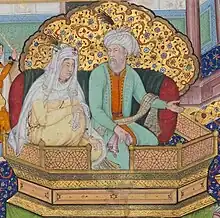
When Temüjin was eight years old, Yesügei decided to betroth him to a suitable girl; he took his heir to the pastures of the prestigious Onggirat tribe, which Hö'elün had been born into, and arranged a marriage between Temüjin and Börte, the daughter of an Onggirat chieftain named Dei Sechen. As the betrothal meant Yesügei would gain a powerful ally, and as Börte commanded a high bride price, Dei Sechen held the stronger negotiating position, and demanded that Temüjin remain in his household to work off his future bride's dowry.[28] Accepting this condition, Yesügei requested a meal from a band of Tatars he encountered while riding homewards alone, relying on the steppe tradition of hospitality to strangers. However, the Tatars recognised their old enemy, and slipped poison into his food. Yesügei gradually sickened but managed to return home; close to death, he requested a trusted retainer called Münglig to retrieve Temüjin from the Onggirat. He died soon after.[29]
Adolescence
Yesügei's death shattered the unity of his people. As Temüjin was only around ten, and Behter around two years older, neither was considered old enough to rule. Led by the widows of Ambaghai, a previous Mongol khan, a Tayichiud faction excluded Hö'elün from the ancestor worship ceremonies which followed a ruler's death and soon abandoned the camp. The Secret History relates that the entire Borjigin clan followed, despite Hö'elün's attempts to shame them into staying with her family.[30] Rashid al-Din and the Shengwu qinzheng lu however imply that Yesügei's brothers stood by the widow. It is possible that Hö'elün may have refused to join in levirate marriage with one, or that the author of the Secret History dramatised the situation.[31] All the sources agree that most of Yesügei's people renounced his family in favour of the Tayichiuds and that Hö'elün's family were reduced to a much harsher life.[32] Taking up a traditional hunter-gatherer lifestyle, they collected roots and nuts, hunted for small animals, and caught fish.[33]
Tensions developed as the children grew older. Both Temüjin and Behter had claims to be their father's heir: although Temüjin was the child of Yesügei's chief wife, Behter was at least two years his senior. There was even the possibility that, as permitted under levirate law, Behter could marry Hö'elün upon attaining his majority and become Temüjin's stepfather.[34] As the friction, excarbated by regular disputes over the division of hunting spoils, intensified, Temüjin and his younger brother Qasar ambushed and killed Behter. This taboo act was omitted from the official chronicles but not from the Secret History, which recounts that Hö'elün angrily reprimanded her sons. Behter's younger full-brother Belgutei did not seek vengeance, and became one of Temüjin's highest-ranking followers alongside Qasar.[35] Around this time, Temüjin developed a close friendship with Jamukha, another boy of aristocratic descent; the Secret History notes that they exchanged knucklebones and arrows as gifts and swore the anda pact—the traditional oath of Mongol blood brothers–at the age of eleven.[36]
As the family lacked allies, Temüjin was likely taken prisoner on multiple occasions.[37] The Secret History relates one such occasion when he was captured by the Tayichiuds who had abandoned him after his father's death. Escaping during a Tayichiud feast, he hid first in the River Onon and then in the tent of Sorkan-Shira, a man who had seen him in the river and not raised the alarm; Sorkan-Shira sheltered Temüjin for three days at great personal risk before allowing him to escape.[38] Temüjin was assisted on another occasion by an adolescent named Bo'orchu who aided him in retrieving stolen horses. Soon afterwards, Bo'orchu joined Temüjin's camp as his first nökor (personal companion; PL nökod).[39] These incidents are indicative of the emphasis the author of Secret History put on personal charisma.[40]
Rise to power
Early campaigns

Accompanied by Belgutei, Temüjin returned to Dei Sechen to marry Börte when he became an adult at fifteen. The Onggirat chieftain, delighted to see the son-in-law he feared had been lost, immediately consented to the marriage, and accompanied the newlyweds back to Temüjin's camp; his wife Čotan presented Hö'elün with a black sable cloak, a sign of great wealth.[41] Seeking a patron, he then chose to approach Toghrul, khan of the Kerait tribe, who had fought alongside Yesügei and sworn the anda pact with him. Toghrul ruled hundreds of miles and commanded up to 20,000 warriors, but he was suspicious of the loyalty of his chief followers and, after being presented with the sable cloak, he welcomed Temüjin into his protection. The two grew close, and Temüjin began to build a following, as nökod such as Jelme entered into his service.[42]
Soon afterwards, seeking revenge for Yesügei's abduction of Hö'elün, around 300 Merkits raided Temüjin's camp. While Temüjin and his brothers were able to hide on Burkhan Khaldun, Börte and Sochigel were abducted. In accordance with levirate law, Börte was given to Chilger, younger brother of Chiledu.[43] Temüjin appealed for aid from Toghrul and his childhood anda Jamukha, who had risen to become chief of the Jadaran tribe. Both chiefs were willing to field armies of 20,000 warriors, and with Jamukha in command, the campaign was soon won. A now-pregnant Börte was recovered successfully and soon gave birth to a son, Jochi; although Temüjin raised him as his own, questions over his true paternity followed Jochi throughout his life.[44] This is narrated in the Secret History and contrasts with Rashid al-Din's account, which protects the family's reputation by removing any hint of illegitimacy.[45]
Temüjin and Jamukha camped together for a year and a half, during which, according to the Secret History, they reforged their anda pact, even sleeping together under one blanket. Traditionally seen as a bond solely of friendship, as presented in the source, Ratchnevsky has questioned if Temüjin was actually serving as Jamukha's nökor, in return for the assistance with the Merkits.[46] Tensions arose and the two leaders parted, ostensibly on account of a cryptic remark made by Jamukha on the subject of camping; scholarly analysis has focused on the active role of Börte in this separation, and whether her ambitions may have outweighed Temüjin's own. In any case, the major tribal rulers remained with Jamukha, but forty-one named leaders joined Temüjin along with many commoners: these included Subutai and others of the Uriankhai, the Barulas, the Olkhonuds, and many more.[47]
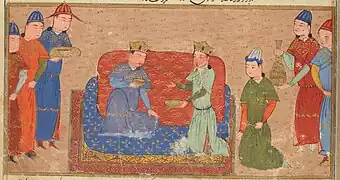
Temüjin was soon acclaimed by his close followers as khan of the Mongols.[48] Toghrul was pleased at his vassal's elevation but Jamukha was resentful. Tensions escalated into open hostility, and in around 1187 the two leaders clashed in battle at Dalan Baljut: the two forces were evenly matched but Temüjin suffered a clear defeat. Later chroniclers including Rashid al-Din instead state that he was victorious but their accounts contradict themselves and each other.[49]
Modern historians such as Ratchnevsky and Timothy May consider it very likely that Temüjin spent a large portion of the decade following the clash at Dalan Baljut as a servant of the Jurchen Jin dynasty.[50] Zhao Hong, a 1221 ambassador from the Song dynasty, recorded that the future Genghis Khan spent several years as a slave of the Jin. Traditionally seen as an expression of Song arrogance, the statement is now thought to be based in fact, especially as no other source convincingly explains Temüjin's activities between Dalan Baljut and c. 1195.[51] Taking refuge across the border was a common practice both for disaffected steppe leaders and disgraced Chinese officials. Temüjin's reemergence c. 1195 having retained significant power indicates that he probably profited in the service of the Jin. As he would later go on to overthrow that state, such an episode, detrimental to Mongol prestige, was omitted from all their sources. Zhao Hong was bound by no such taboos.[52]
Defeating rivals

The sources do not agree on the events of Temüjin's return to the steppe. In early summer 1196, he participated in a joint campaign with the Jin against the Tatars, who had begun to exert their power. As a reward, the Jin awarded him the honorific cha-ut kuri. At around the same time, he assisted Toghrul with reclaiming the lordship of the Kereit, which had been taken by a family member with the support of the powerful Naiman tribe.[53] Toghrul was given the title of Ong Khan by the Jin, traditionally as a reward for his support during the Tatar campaign. In fact, Toghrul may not have participated in the warfare, and the title was only thus given as a pacificatory gesture. In all versions of events, the actions of 1196 fundamentally changed Temüjin's position in the steppe—he was now Toghrul's equal ally, rather than his junior vassal.[54]
Jamukha had behaved poorly following his victory at Dalan Baljut, allegedly beheading enemy leaders and humiliating their corpses, or boiling seventy prisoners alive. A number of disaffected followers, including Yesügei's nökor Münglig and his sons, defected to Temüjin as a consequence.[55] Temüjin was able to subdue the disobedient Jurkin tribe that had previously offended him at a feast and refused to participate in the Tatar campaign. After eliminating their leaders, he had Belgutei symbolically break a leading Jurkin's back in a staged wrestling match in retribution. This latter incident, which contravened Mongol customs of justice, was only noted by the author of the Secret History, who openly disapproved. These events occurred c. 1197.[56]
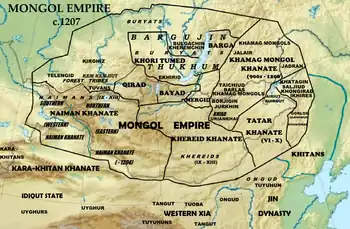
During the following years, Temüjin and Toghrul campaigned separately and together against the Merkits, the Naimans, and the Tatars. In around 1201, a collection of dissatisfied tribes including the Onggirat, the Tayichiud, and the Tatars, swore to break the domination of the Borjigin-Kereit alliance, electing Jamukha as gurkhan and their leader. After some initial successes, this loose confederation was routed at Yedi Qunan, and Jamukha was forced to beg for Toghrul's clemency.[57] Desiring complete supremacy in eastern Mongolia, Temüjin defeated first the Tayichiud and then, in 1202, the Tatars; after both campaigns, he executed the clan leaders and took the remaining warriors into his service. These included Sorkan-Shira, who had come to his aid previously, and a young warrior named Jebe, who, by killing Temüjin's horse and refusing to hide that fact, had displayed military skill and personal courage.[58]
The absorption of the Tatars left three military powers in the steppe: the Naimans in the west, the Mongols in the east, and the Kereit in between.[59] Seeking to cement his position, Temüjin proposed that his son Jochi marry one of Toghrul's daughters. Led by Toghrul's son Senggum, the Kereit elite believed the proposal to be an attempt to gain control over their tribe, while the doubts over Jochi's parentage would have offended them further. In addition, Jamukha drew attention to the threat Temüjin posed to the traditional steppe aristocracy. Yielding eventually to these demands, Toghrul attempted to lure his vassal into an ambush, but his plans were overheard by two herdsmen. Temüjin was able to gather some of his forces, but was soundly defeated at the Battle of Qalaqaljid Sands.[60]
"[Temüjin] raised his hands and looking up at Heaven swore, saying "If I am able to achieve my "Great Work", I shall [always] share with you men the sweet and the bitter. If I break this word, may I be like the water of the River, drunk up by others."
Among officers and men there was none who was not moved to tears.
Temüjin retreated southeast to Baljuna, an unidentified lake or river, where he waited for his scattered forces to regroup: Bo'orchu had lost his horse and was forced to flee on foot, while Temüjin's badly wounded son Ögedei had been transported and tended to by Borokhula, a leading warrior. He called in every possible ally and swore a famous oath of loyalty, later known as the Baljuna Covenant, to his faithful followers, which would later grant them exclusivity and prestige.[62] The oath-takers of Baljuna were a very heterogenous group—men from nine different tribes, who included Christians, Muslims, and Buddhists united only by loyalty to Temüjin and to each other; this group became a model for the later empire, being termed a "proto-government of a proto-nation" by historian John Man.[63] The Baljuna Covenant was omitted from the Secret History—as the group was predominantly non-Mongol, the author presumably wished to downplay the role of other tribes.[64]
A ruse de guerre involving Qasar allowed the Mongols to catch the Kereit unawares at the Jej'er Heights, but though the ensuing battle still lasted three days, it ended in a decisive victory for Temüjin. Toghrul and Senggum were both forced to flee, and while the latter escaped to Tibet, Toghrul was killed by a Naiman who did not recognise him. Temüjin sealed his victory by absorbing the Kereit elite into his own tribe: he took the princess Ibaqa to be his own wife, and gave her sister Sorghaghtani and niece Doquz to his youngest son Tolui.[65] The ranks of the Naimans had swelled due to the arrival of Jamukha and others defeated by the Mongols, and they soon prepared for war. Temüjin was informed of these events by Alaqush, the sympathetic ruler of the Ongud tribe. In the Battle of Chakirmaut, which occurred in May 1204 in the Altai Mountains, the Naimans were decisively defeated: their leader Tayang Khan was killed, and his son Kuchlug was forced to flee west.[66] The Merkits were decimated later that year, while Jamukha, who had abandoned the Naimans at Chakirmaut, was betrayed to Temüjin by companions who were executed for their lack of loyalty. According to the Secret History, Jamukha convinced his childhood anda to execute him honourably; other accounts state that he was killed by dismemberment.[67]
Early reign: reforms and Chinese campaigns (1206—1215)
Kurultai of 1206 and reforms
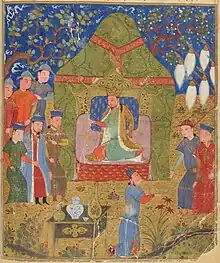
Now sole ruler in the steppe, Temüjin held a kurultai at the source of the Onon River in 1206.[69] Here, he formally adopted the title Genghis Khan, the etymology and meaning of which has been much debated. Some commentators hold that the title had no meaning, simply representing Temüjin's eschewment of the traditional "gurkhan" title, which had been accorded to Jamukha and was thus of lesser worth.[70] Another theory suggests that the word "Genghis" bears connotations of strength, firmness, hardness, or righteousness.[71] A third hypothesis proposes that the title is related to the Turkic "tängiz", meaning "sea" or "ocean"; the title "Genghis Khan" would mean "master of the ocean", and as the ocean was believed to surround the earth, the title ultimately implied "Universal Ruler".[72]
Having attained control over one million people and over fifteen million animals,[73] Genghis Khan began what May has termed a "social revolution".[74] As traditional tribal systems had primarily evolved to benefit small clans and families, they were unsuitable as the foundations for larger states and had been the downfall of previous steppe confederations. Aware that a different organisational structure was required for the functioning of his new nation, Genghis began a series of administrative reforms designed to suppress the power of tribal loyalties and to replace them with unconditional loyalty to the khan and the ruling family.[75] As most of the traditional tribal leaders had been killed during his rise to power, Genghis was able to reconstruct the Mongol social hierarchy in his favour. The highest tier was occupied solely by the families of the Khan and his brothers, who became known as the altan uruq (lit. "Golden Family") or chaghan yasun (lit. "white bone"); underneath them came the qara yasun (lit. "black bone"; sometimes qarachu), composed of the surviving pre-empire aristocracy and the most important of the new families.[76]
To break any concept of tribal loyalty, the entirety of Mongol society was reorganised into a decimal system of military organisation. Every man between the age of fifteen and seventy was conscripted into a minqan (PL minkad), a unit of a thousand soldiers, which was further subdivided into units of hundreds (jaghun, PL jaghat) and tens (arban, PL arbat).[77] The units also encompassed each man's household, meaning that each military minqan was supported by a minqan of households in a defined military–industrial complex. Each minqan operated as both political and social units, while the warriors of defeated tribes were dispersed to different minqad so that they could not rebel as a single body. This was intended to ensure the disappearance of old tribal identities, replacing them with loyalty to the Yeke Mongol Ulus (lit. "Great Mongol State") and to commanders who had gained their rank through meritocratic skill and loyalty to the khan.[78] This particular reformation proved extremely effective—even after the division of the Mongol Empire, fragmentation never happened along tribal lines. Instead, the Borjigin Genghisids continued to reign unchallenged, in some cases until as late as the 1700s, and even powerful non-imperial dynasts such as Timur and Edigu were compelled to rule from behind a Genghisid puppet ruler.[79]
Genghis' senior nökod were appointed to the highest ranks and received the greatest honours. Bo'orchu and Muqali were each given ten thousand men (tumen, PL tumed) to lead as commanders of the right and left wings of the army respectively.[80] The other nökod were given commands of one of the ninety-five minkad. Many of these men were born to low social status: Ratchnevsky cites Jelme and Subutai, the sons of blacksmiths, in addition to a carpenter, a shepherd, and even the two herdsmen who had warned Temüjin of Toghrul's plans in 1203.[81] As a special privilege, Genghis allowed certain loyal commanders to retain the tribal identities of their units. Alakush of the Ongud was allowed to retain five thousand warriors of his tribe because his son had married Genghis' daughter Alakhai Bekhi, while Chigu and Alchi of the Onggirat, as husband to Genghis' sister Temülen and brother to Börte respectively, were granted three minkad each. These large exemptions were bestowed because of existing quda (lit. "marriage alliance") pacts.[82]
A key tool which underpinned these reforms was the expansion of the keshig (lit. "bodyguard"). After Temüjin's defeat of Toghrul in 1203, he had appropriated this Kereit institution in a minor form, but at the 1206 kurultai its numbers were greatly expanded, from 1,150 to 10,000 men. The keshig was not only the khan's bodyguard, but his household staff, a military academy, a guarantor of loyalty, and the basis of governmental administration.[83] All the warriors in this elite corps, divided into an 8,000-strong day guard and two minqad of night guards and quiver bearers, were brothers or sons of military commanders, and were essentially hostages. The keshigten (lit. "keshig members") nevertheless received special privileges and direct access to the khan, whom they would serve in all respects during both peace and war, and who in return would evaluate their capabilities and their potential to govern or command.[84][lower-alpha 3]
Consolidation of power (1206–1210)
From 1206 to 1209, Genghis Khan was predominantly focused on consolidating and maintaining his new nation.[86] He faced a challenge from Kokechu, the son of Münglig, the trusted retainer of Yesügei to whom Genghis had given his mother Hö'elün in marriage. Kokechu was the shaman who had proclaimed Temüjin as Genghis Khan and taken the Tengrist title "Teb Tenggeri" (lit. "Wholly Heavenly") on account of his sorcery. He was very influential among the Mongol commoners and sought to divide the imperial family.[87] Genghis' oldest sibling Qasar was the first of Kokechu's targets—always distrusted by his brother, he was humiliated and almost imprisoned on false charges before Hö'elün intervened by publicly reprimanding her eldest son. Nevertheless, Kokechu's power steadily increased. When Genghis' youngest brother Temüge attempted to intervene he too was publicly shamed.[88] Börte saw the threat Kokechu posed and warned Genghis, who still superstitiously revered the shaman; relenting, he allowed Temüge to assassinate Kokechu and usurped the shaman's position as the Mongols' highest spiritual authority.[89]
During these years, the Mongols imposed their control on surrounding areas. Genghis dispatched Jochi northwards in 1207 to subjugate the Hoi-yin Irgen, a collection of tribes on the edge of the Siberian taiga, and, having secured a marriage alliance with the Oirats and defeated the Yenisei Kyrgyz, took control of the region's grain trade, fur trade, and gold mines.[90] Mongol armies also rode westwards, defeating the Naiman-Merkit alliance on the River Irtysh in late 1208. Their khan was killed and Kuchlug fled into Central Asia.[91] Led by Barchuk, the Uyghurs freed themselves from the suzerainty of the Qara-Khitai and pledged themselves to Genghis in 1211 as the first sedentary society to submit to the Mongols.[92]
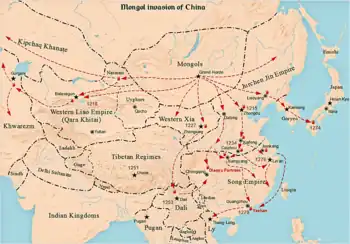
The Mongols had started raiding the border settlements of the Tangut-led Western Xia kingdom in 1205, ostensibly in retaliation for allowing Senggum, Toghrul's son, refuge;[93] more prosaic explanations include rejuvenating the depleted Mongol economy with an influx of fresh goods and livestock,[94] or simply subjugating a semi-hostile state to protect the nascent nation.[95] Most Xia troops were stationed along the southern and western borders of the kingdom to guard against attacks from the Song and Jin dynasties respectively, while its northern border relied only on the Gobi desert for protection, unlike the Jin's which was strongly fortified.[96] After a raid in 1207 sacked the fortress of Wulahai, Genghis decided to personally lead a full-scale invasion in 1209.[97]
Wulahai was captured again in May and the Mongols advanced on the capital Zhongxing (modern-day Yinchuan) but suffered a reverse against a Xia army. After a two-month stalemate, Genghis broke the deadlock with a successfully-executed feigned retreat.[98] Although Zhongxing was now mostly undefended, lacking any siege equipment better than crude battering rams, the Mongols were unable to progress the siege.[99] Genghis' innovative attempt to redirect the Yellow River into the city with a dam initially worked, but the poorly-constructed earthworks broke—possibly breached by the Xia—in January 1210 and the Mongol camp was flooded, forcing them to retreat. A peace treaty was soon formalized: the Xia emperor Xiangzong submitted and handed over tribute, including his daughter Chaka, in exchange for the Mongol withdrawal.[100]
Campaign against the Jin (1211–1215)
Wanyan Yongji usurped the Jin throne in 1209. He had previously served on the steppe frontier and Genghis greatly disliked him;[101] he also declined to aid the Xia against the Mongols.[102] When asked to submit and pay the annual tribute to Yongji in 1210, Genghis instead mocked the emperor, spat, and rode away from the Jin envoy—a challenge which meant war.[103] He had made preparations for an invasion of Jin, despite the possibility of being outnumbered eight-to-one by 600,000 Jin soldiers, since learning of their internal instabilities in 1206.[104] Genghis had two aims: to take vengeance for past wrongs committed by the Jin, foremost among which was the death of Ambaghai Khan in the mid-12th century, and to win the vast amounts of plunder his troops and vassals expected.[105]
After calling for a kurultai in March 1211, Genghis launched his invasion of Jin China in May, reaching the outer Jin defense ring the following month. These border fortifications were guarded by the Ongud tribe, who were friendly to the Mongols—through his daughter Alakhai Beki, Genghis held a quda alliance with their leader Alaqush—and allowed them to pass without difficulty.[106] The three-pronged chevauchée aimed both to plunder and burn a vast area of Jin territory to deprive them of supplies and popular legitimacy, and to secure the mountain passes which allowed access to the North China Plain.[107] The Jin lost numerous towns and were hindered by a series of defections, the most prominent of which was Khitan Shimo Ming'an, whose betrayal led directly to Muqali's victory at the Battle of Huan'erzhui in autumn 1211.[108] The campaign was halted in 1212 when Genghis was wounded by an arrow during the siege of Xijing (modern Datong).[109] Following the failure at Xijing, Genghis set up a corps of siege engineers, which recruited 500 Jin experts over the next two years.[110]
The defenses of Juyong Pass had been strongly reinforced by the time the conflict resumed in 1213, but a Mongol detachment led by Jebe managed to infiltrate the pass and surprise the elite Jin defenders, opening the road to the Jin capital Zhongdu (modern-day Beijing).[111] The Jin administration began to disintegrate: after the Khitans entered open rebellion, Hushahu, the commander of the forces at Xijing, abandoned his post and staged a coup in Zhongdu, killing Yongji and installing his own puppet ruler, Xuanzong.[112] This governmental breakdown was fortunate for Genghis' forces—emboldened by their victories, they had seriously overreached and lost their initiative. Unable to do more than sit before Zhongdu's fortifications while his army suffered from an epidemic and famine. The Mongols are reported to have resorted to cannibalism. Genghis opened peace negotiations despite his commanders' militarism.[113] He secured tribute, including 3,000 horses, 500 slaves, a Jin princess, and massive amounts of gold and silk, before breaking the siege in spring 1214 and setting off homewards in May 1214.[114]
With the northern Jin lands ravaged by plague and the Mongols, Xuanzong decided to move the capital and imperial court 600 kilometres (370 mi) southwards to Kaifeng.[115] Genghis saw this move as a betrayal of the peace treaty and immediately prepared to return, even though he had been away from home for three years.[116] According to Christopher Atwood, it was only at this juncture that Genghis decided to fully conquer northern China.[117] Muqali captured numerous towns in Liaodong during winter 1214–15, and although the inhabitants of Zhongdu surrendered to Genghis on 31 May 1215, the city was sacked and looted.[118] When Genghis returned to Mongolia in early 1216, Muqali was left in command in China.[119] He waged a brutal but effective campaign against the unstable Jin until his death in 1223.[120]
Later reign: western expansion and return to China (1216–1227)
Defeating rebellions and Qara Khitai (1216–1218)
In 1207, Genghis had appointed a man named Qorchi as governor of the subdued Hoi-yin Irgen tribes. Appointed not for his talents but for prior services rendered, Qorchi was a poor choice, and his habit of taking too many concubines for his harem led the tribes to rebel and take him prisoner in early 1216. Boroqul, one of Genghis' highest-ranking nökod, was ambushed and killed the following year.[121] The khan was livid at the loss of his close friend and prepared to personally lead a retaliatory campaign; eventually dissuaded from this course, he dispatched his eldest son Jochi and a Dörbet commander. They managed to surprise and defeat the rebels, securing control over this economically important region.[122]
Kuchlug, the Naiman prince who had been defeated in 1204, had usurped the throne of the Central Asian Qara Khitai dynasty between 1211 and 1213. He was a greedy and arbitrary ruler who probably earned the enmity of the native Islamic populace whom he attempted to forcibly convert to Buddhism.[123] Genghis sensed that Kuchlug might be a potential threat to his empire, and Jebe was sent with an army of 20,000 cavalry to Kashgar; he undermined Kuchlug's rule by emphasising the Mongol policies of religious tolerance and gained the loyalty of the local elite.[124] Kuchlug was forced to flee southwards to the Pamir Mountains, but was captured by local hunters. Decapitated by the Mongols, his corpse was paraded through Qara Khitai, and Jebe proclaimed the end of religious persecution in the region.[125]
Invasion of the Khwarazmian Empire (1219–1221)
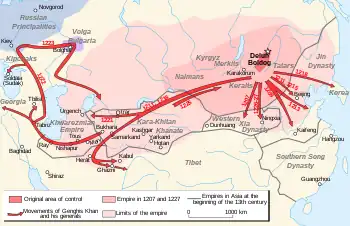
Genghis had now attained complete control of the eastern portion of the Silk Road, and his territory bordered that of the Khwarazmian Empire, which ruled over much of Central Asia, Persia and Afghanistan.[126] Merchants from both sides were eager to restart trading, which had halted during Kuchlug's rule—the Khwarazmian ruler Muhammad II dispatched an envoy shortly after the Mongol capture of Zhongdu, while Genghis instructed the ortoq, the Mongol trading partners, to obtain the high-quality textiles and steel of Central and Western Asia.[127] Many members of the altan uruq invested in one particular caravan of 450 merchants which set off to Khwarazmia in 1218 with a massive quantity of goods. Muhammad had however grown suspicious of Genghis' intentions, and when Inalchuq, the governor of the Khwarazmian border town of Otrar, decided to halt the caravan, massacre the merchants on grounds of espionage, and seize the goods, the Khwarazmshah either supported Inalchuq or turned a blind eye.[128] A Mongol ambassador was sent with two companions to avert war, but he was killed and his companions humiliated. The killing of an envoy infuriated Genghis, who resolved to leave Muqali with a small force in North China and invade Khwarazmia with most of his army.[129]
Muhammad's empire was large but disunited: he ruled alongside his mother Terken Khatun in what Peter Golden termed "an uneasy diarchy", while the Khwarazmian nobility and populace were discontented with his warring and centralization of government. For these reasons and others he declined to meet the Mongols in the field, instead garrisoning his unruly troops in his major cities.[130] This allowed the lightly armoured, highly mobile Mongol armies uncontested superiority outside city walls.[131] Otrar was besieged in autumn 1219—the siege dragged on for five months, but in February 1220 the city fell and Inalchuq was executed.[132] Genghis had meanwhile divided his forces. Leaving his sons Chagatai and Ogedei besieging the city, he had sent Jochi northwards down the Syr Darya river and another force southwards into central Transoxiana, while he and Tolui took the main Mongol army across the Kyzylkum Desert, surprising the garrison of Bukhara in a pincer movement.[133]

Bukhara's citadel was captured in February 1220 and Genghis moved against Muhammad's residence Samarkand, which fell the following month.[134] Bewildered by the speed of the Mongol conquests, Muhammad fled from Balkh, closely followed by Jebe and Subutai; the two generals pursued the Khwarazmshah until his death from dysentry on a Caspian Sea island in winter 1220/21. Before his death, he nominated his eldest son Jalal al-Din as his successor.[135] Jebe and Subutai then set out on a massive 7,500 kilometres (4,700 mi) expedition around the Caspian Sea. Later called the Great Raid, this lasted four years and saw the Mongols come into contact with medieval Europe for the first time.[136] Meanwhile, the Khwarazmian capital of Gurganj was being besieged by Genghis' three eldest sons; a long siege ended in spring 1221 amid brutal urban conflict.[137] Jalal al-Din moved southwards to Afghanistan, gathering forces on the way and defeating a Mongol unit under the command of Shigi Qutuqu, Genghis' adopted son, in the Battle of Parwan.[138] Jalal was weakened by arguments among his commanders, and losing decisively at the Battle of the Indus in November 1221, he was compelled to swim across the river into India.[139]
Genghis' youngest son Tolui was concurrently conducting a brutal campaign in the regions of Khorasan. Every city that resisted was destroyed in a programme of concentrated devastation—Nishapur, Merv and Herat, three of the largest and wealthiest cities in the world, were all annihilated.[lower-alpha 4][141] This campaign established Genghis' lasting image as a ruthless, inhumane conqueror. Persian historians placed the death toll from the three sieges alone at over 5.7 million—numbers regarded as grossly exaggerated by modern scholarship.[142] Nevertheless, even a total death toll of 1.25 million for the entire campaign, as estimated by John Man, would have been a demographic catastrophe.[143]
Return to China and final campaign (1222–1227)
Genghis abruptly halted his Central Asian campaigns in 1221.[144] Initially aiming to return via India, Genghis realised that the heat and humidity of the South Asian climate impeded his army's skills, while the omens were additionally unfavourable.[145] Although the Mongols spent much of 1222 repeatedly overcoming rebellions in Khorasan, they withdrew completely from the region to avoid overextending themselves, setting their new frontier on the Amu Darya river.[146] During his lengthy return journey, Genghis prepared a new administrative division which would govern the conquered territories, appointing darughachi (commissioners, lit. "those who press the seal") and basqaq (local officials) to manage the region back to normalcy.[147] He also summoned and spoke with the Daoist patriarch Changchun in the Hindu Kush. The khan listened attentively to Changchun's teachings and granted his followers numerous privileges, including tax exemptions and authority over all monks throughout the empire—a grant which the Daoists would later use to try to gain superiority over Buddhism.[148]
The usual reason given for the halting of the campaign is that the Western Xia, having declined to provide auxiliaries for the 1219 invasion, had additionally disobeyed Muqali in his campaign against the remaining Jin in Shaanxi province.[144] May has disputed this, arguing that the Xia fought in concert with Muqali until his death in 1223, when, frustrated by Mongol control and sensing an opportunity with Genghis in Central Asia, they ceased fighting.[149] In either case, Genghis initially attempted to resolve the situation diplomatically, but when the Xia elite failed to come to an agreement on the hostages they were to send to the Mongols, he lost patience.[150] Returning to Mongolia in early 1225, he spent the year in preparation for the campaign, which began in the first months of 1226 with the capture of Khara-Khoto on the Xia's western border.[151]
The invasion proceeded apace. Genghis ordered that the cities of the Gansu Corridor be sacked one by one, granting clemency only to a few.[152] Having crossed the Yellow River in autumn, the Mongols besieged present-day Lingwu, located just 30 kilometres (19 mi) south of the Xia capital Zhongxing in November. On 4 December, Genghis decisively defeated a Xia relief army; the khan left the siege of the defenceless capital to his generals and moved southwards with Subutai to plunder and secure Jin territories.[153]
Death and succession
Genghis, who had suffered a fall from his horse while hunting in the winter, became increasingly ill during the following months. This slowed the siege's progress, as his sons and commanders urged him to end the campaign and return to Mongolia to recover, arguing that the urban-bound Xia would still be there another year.[154] Incensed by insults from Xia's leading commander, Genghis insisted that the siege be continued. He died in August 1227, but his death was kept a closely guarded secret and Zhongxing, unaware, fell the following month. The city was put to the sword and its population was treated with extreme savagery—the Xia civilisation was essentially extinguished in what Man described as "very successful ethnocide".[155] The exact nature of the khan's death has been the subject of intense speculation. Rashid al-Din and the Yuán Shǐ mention he suffered from an illness—possibly malaria, typhus, or bubonic plague.[156] Marco Polo attests that he was shot by an arrow during a siege, while Carpini reports that Genghis was struck by lightning. Legends sprang up around the event—the most famous recounts how the beautiful Gurbelchin, formerly wife to the Xia emperor, castrated Genghis with a concealed dagger during sexual intercourse.[157]
After his death, Genghis was transported back to Mongolia and buried on or near the sacred Burkhan Khaldun peak in the Khentii Mountains, on a site he had personally chosen years before.[158] Specific details of the funeral procession and burial were not made public knowledge; the mountain, declared ikh khorig (lit. "Great Taboo"; i.e. prohibited zone), was off-limits to all but its Uriankhai guard. When Ogedei acceded to the throne in 1229, the grave was honoured with three days of offerings and the sacrifice of thirty maidens.[159][160] Ratchnevsky theorises that the Mongols, who had no knowledge of embalming techniques, may have buried the khan in the Ordos to avoid his body decomposing in the summer heat; Atwood emphatically rejects this hypothesis.[161]
Succession
.jpg.webp)
The tribes of the Mongol steppe had no fixed succession system, but often defaulted to some form of ultimogeniture—succession of the youngest son—on the grounds that unlike his older brothers, the youngest son would not have had time to gain a following for himself and needed the help of his father's inheritance.[163] However, it has been noticed that this inheritance applied only to property, not to titles.[164] Through the Mongol appanage system, Genghis allocated lands and populations as property to each member of his close family. His brothers Qasar, Hachiun, Temüge, and Belgutei were given lands along the Greater Khingan mountains in the east,[165] and the lands of his three elder sons were located in the west: for Jochi, along the Irtysh river, extending into Siberia and the territory of the Kipchaks; for Chagatai, the former Qara Khitai territories surrounding Almaligh in Turkestan; for Ogedei, lands in Dzungaria;[lower-alpha 5] and for Tolui the Mongolian fatherland near the Altai Mountains, as per tradition.[167]
The Secret History records that he chose his successor at the behest of his wife Yisui while preparing for the Khwarazmian campaigns in 1219; Rashid al-Din, on the other hand, states that the decision came before Genghis' final campaign against the Xia.[168] Regardless of the date, there were five possible candidates: Genghis' four sons and his youngest brother Temüge, who had the weakest claim and who was never seriously considered.[169] Even though there was a strong possibility Jochi was illegitimate Genghis was not particularly concerned by this;[170] nevertheless, he and Jochi became increasingly estranged over time. This was due to Jochi's preference for remaining in and growing his own appanage; his actions during the Siege of Gurganj, where his reluctance to destroy a wealthy city that would become part of his territory eventually led to his failure to give Genghis the khan's share of the booty, exacerbated the tensions.[171] Genghis was angered by Jochi's refusal to return to him in 1223, allegedly because of his love for hunting, and was considering sending Ogedei and Chagatai to bring him back to heel when news came that Jochi had prematurely died from a serious illness.[172]
Chagatai's attitude towards Jochi's possible succession—he had termed his elder brother "a Merkit bastard" and had brawled with him in front of their father—led Genghis to view him as uncompromising, arrogant, and narrow-minded, despite his great knowledge of Mongol legal customs.[173] His elimination left Ogedei and Tolui as the two primary candidates. Tolui was unquestionably superior in military terms—his campaign in Khorasan had broken the Khwarazmian Empire, while his elder brother was far less able as a commander.[174] Ogedei was also known to drink excessively even by Mongol standards—it was eventually the cause of his death in 1241.[175] However, he possessed talents all his brothers lacked—he was generous and courteous, well-liked by all in the nation. Aware of his own lack of military skill, he was able to trust his capable subordinates, and unlike his elder brothers, compromise on issues; he was also more likely to preserve Mongol traditions than Tolui, whose wife Sorghaghtani, herself a Nestorian Christian, was a patron of many religions including Islam. Ogedei was thus recognised as the heir to the Mongol throne.[176]
Serving as regent after Genghis' death, Tolui established a precedent for the customary traditions after khan's death. These included: the halting of all offensive military actions involving Mongol troops, the establishment of a lengthy mourning period, which the regent would oversee, and the holding of a kurultai which would nominate successors and select them.[177] For Tolui, this presented an opportunity. He was still a viable candidate for succession and had the support of the family of Jochi. Any general kurultai, attended by the commanders Genghis had promoted and honoured, would however observe their former ruler's desires without question and appoint Ogedei as ruler. It has been suggested that Tolui's reluctance to hold the kurultai was driven by the knowledge of the threat it posed to his ambitions.[178] In the end, Tolui had to be convinced by Yelu Chucai to hold the kurultai; in 1229, it crowned Ogedei as khan, with Tolui in attendance.[179]
Legacy
Medieval depictions and assessment
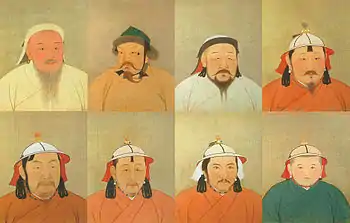
Genghis Khan never allowed his image to be depicted in any medium; as a result, any painting, sculpture, or engravings are interpretations of the writings of historians, most writing long after his death.[180] The two earliest statements come from the Persian chronicler Juzjani, who relied on Khorasani eyewitnesses, and the contemporary Song diplomat Zhao Hong—both record that he was tall and strong with a powerful stature. Juzjani additionally remarks on the khan's "cat's eyes", mirroring a similar statement Dei Sechen, Genghis' father-in-law, is recorded saying on meeting him as a nine-year old.[181] Another written description is found in the Jami al-tawarikh, which states that Genghis Khan and his Borjigin ancestors had blue-green eyes and either red hair or a ruddy complexion which Kublai Khan did not inherit. The factual nature of this description is considered controversial.[182][183]
Genghis Khan had a notably positive reputation among some western European authors in the Middle Ages, who knew little concrete information about his empire in Asia.[184] The Italian explorer Marco Polo said that Genghis Khan "was a man of great worth, and of great ability, and valor",[185][186] while philosopher and inventor Roger Bacon applauded the scientific and philosophical vigor of Genghis Khan's empire,[187] and Geoffrey Chaucer praised the "great renown of Cambinskan".[188]
In modern culture
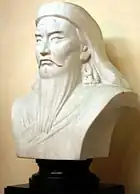
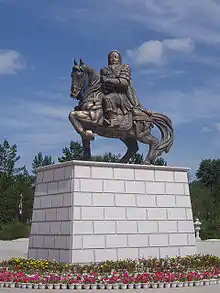
During the communist period in Mongolia, Genghis was often described by the government as a reactionary figure, and positive statements about him were avoided.[189] In 1962, the erection of a monument at his birthplace and a conference held in commemoration of his 800th birthday led to criticism from the Soviet Union and the dismissal of secretary Tömör-Ochir of the ruling Mongolian People's Revolutionary Party Central Committee.
In the early 1990s, the memory of Genghis Khan underwent a powerful revival, partly in reaction to its suppression during the Mongolian People's Republic period. Genghis Khan became a symbol of national identity for many younger Mongolians, who maintain that the historical records written by non-Mongolians are unfairly biased against Genghis Khan and that his butchery is exaggerated, while his positive role is underrated.[190]
In Mongolia today, Genghis Khan's name and likeness appear on products, streets, buildings, and other places. His face can be found on everyday commodities, and on the largest denominations of 500, 1,000, 5,000, 10,000, and 20,000 Mongolian tögrög (₮). Mongolia's main international airport in Ulaanbaatar is named Chinggis Khaan International Airport, and there is a 40m-high equestrian statue of Genghis Khan east of the Mongolian capital. There has been talk about regulating the use of his name and image to avoid trivialization.[191] Genghis Khan's birthday, on the first day of winter (according to the Mongolian lunar calendar), is a national holiday.[192]
References
Notes
- See § Name and title
- The Mongolian People's Republic chose to commemorate the 800th anniversary of Temüjin's birth in 1962.[18]
- Commanders such as Subutai, Chormaqan, and Baiju all started out in the keshig, before being given command of their own force.[85]
- Herat initially surrendered to Tolui, but later rebelled and was destroyed in 1222; its population was massacred.[140]
- Ogedei's allocation was relatively small in area because he would receive a large amount of personal land when khagan.[166]
Citations
- You et al. 2021, pp. 347–348.
- Ratchnevsky 1991, pp. x–xi.
- Pelliot 1959, p. 281.
- Bawden 2022, § "Introduction"; Wilkinson 2012, p. 776; Morgan 1990.
- Bawden 2022, § "Introduction".
- Porter 2016, p. 24; Fiaschetti 2014, pp. 77–82.
- Morgan 1986, pp. 4–5.
- Ratchnevsky 1991, p. xii.
- Sverdrup 2017, p. xiv.
- Hung 1951, p. 481.
- Waley 2002, pp. 7–8; Morgan 1986, p. 11.
- Ratchnevsky 1991, pp. xiv–xv.
- Morgan 1986, pp. 16–17.
- Sverdrup 2017, p. xvi.
- Morgan 1986, p. 18; Ratchnevsky 1991, pp. xv–xvi.
- Ratchnevsky 1991, p. xv; Atwood 2004, p. 117; Morgan 1986, pp. 18–21.
- Sverdrup 2017, pp. xiv–xvi; Wright 2017.
- Morgan 1986, p. 55.
- Ratchnevsky 1991, pp. 17–18.
- Ratchnevsky 1991, pp. 17–18; Pelliot 1959, pp. 284–287.
- Pelliot 1959, p. 287; Ratchnevsky 1991, p. 19.
- Atwood 2004, p. 97.
- Ratchnevsky 1991, pp. 14–15; May 2018, pp. 20–21.
- Pelliot 1959, pp. 289–291; Man 2004, pp. 67–68; Ratchnevsky 1991, p. 17.
- Brose 2014, § "The Young Temüjin"; Pelliot 1959, p. 288.
- Ratchnevsky 1991, p. 17.
- Ratchnevsky 1991, pp. 15–19.
- Ratchnevsky 1991, pp. 20–21; Fitzhugh, Rossabi & Honeychurch 2009, p. 100.
- Ratchnevsky 1991, pp. 21–22; Broadbridge 2018, pp. 50–51.
- Ratchnevsky 1991, p. 22; May 2018, p. 25; de Rachewiltz 2015, § 71–73.
- Ratchnevsky 1991, pp. 22–3; Atwood 2004, pp. 97–98.
- Brose 2014, § "The Young Temüjin"; Atwood 2004, p. 98.
- May 2018, p. 25.
- May 2018, pp. 25–26.
- Ratchnevsky 1991, pp. 23–4; de Rachewiltz 2015, §76–78.
- Man 2004, p. 74; de Rachewiltz 2015, §116; Fitzhugh, Rossabi & Honeychurch 2009, p. 101.
- Ratchnevsky 1991, pp. 25–26; Fitzhugh, Rossabi & Honeychurch 2009, pp. 100–101.
- Ratchnevsky 1991, pp. 26–7; May 2018, pp. 26–27.
- May 2018, p. 28.
- Ratchnevsky 1991, p. 27.
- May 2018, p. 28; Ratchnevsky 1991, p. 31.
- de Hartog 1999, pp. 14–15; Ratchnevsky 1991, pp. 32–33; May 2018, pp. 28–29.
- Ratchnevsky 1991, pp. 34–35; Brose 2014, § "Emergence of Chinggis Khan".
- May 2018, p. 30; Bawden 2022, § "Early struggles".
- Ratchnevsky 1991, pp. 34–35; May 2018, pp. 30–31.
- Ratchnevsky 1991, pp. 37–38.
- May 2018, p. 31; Ratchnevsky 1991, pp. 38–41.
- Atwood 2004, p. 98; Brose 2014, § "Building the Mongol Confederation".
- Ratchnevsky 1991, pp. 44–47.
- Ratchnevsky 1991, pp. 49–50; May 2018, p. 32.
- Ratchnevsky 1991, pp. 49–50.
- Ratchnevsky 1991, pp. 49–50; May 2018, p. 32; Fitzhugh, Rossabi & Honeychurch 2009, p. 101.
- Ratchnevsky 1991, pp. 52–53; Pelliot 1959, pp. 291–295.
- Ratchnevsky 1991, pp. 52–53; Sverdrup 2017, p. 56.
- Ratchnevsky 1991, pp. 46–47; May 2018, p. 32.
- Ratchnevsky 1991, pp. 54–56.
- Ratchnevsky 1991, pp. 61–62; May 2018, pp. 34–35.
- Ratchnevsky 1991, pp. 63–67; de Hartog 1999, pp. 21–22; Fitzhugh, Rossabi & Honeychurch 2009, p. 102.
- May 2018, p. 36.
- Atwood 2004, p. 98; Ratchnevsky 1991, pp. 67–70; May 2018, pp. 36–37.
- Cleaves 1955, p. 397.
- Brose 2014, § "Building the Mongol Confederation"; Ratchnevsky 1991, pp. 70–73; Man 2004, pp. 96–98.
- Man 2014, p. 40; Weatherford 2004, p. 58; Biran 2012, p. 38.
- Man 2014, p. 40.
- Ratchnevsky 1991, pp. 78–80; Atwood 2004, p. 98; Lane 2004, pp. 26–27.
- Sverdrup 2017, pp. 81–83; Ratchnevsky 1991, pp. 83–86.
- Brose 2014, § "Building the Mongol Confederation"; Fitzhugh, Rossabi & Honeychurch 2009, p. 103; Ratchnevsky 1991, pp. 86–88; McLynn 2015, pp. 90–91.
- May 2012, p. 36.
- Fitzhugh, Rossabi & Honeychurch 2009, p. 103.
- Pelliot 1959, p. 296; Favereau 2021, p. 37.
- Ratchnevsky 1991, p. 89; Pelliot 1959, p. 297.
- Ratchnevsky 1991, pp. 89–90; Pelliot 1959, pp. 298–301.
- Weatherford 2004, p. 65.
- May 2018, p. 39.
- Ratchnevsky 1991, p. 90; Fitzhugh, Rossabi & Honeychurch 2009, p. 104; McLynn 2015, p. 97.
- Atwood 2004, pp. 505–506; May 2018, p. 39.
- May 2007, pp. 30–31; McLynn 2015, p. 99.
- May 2018, pp. 39–40; Fitzhugh, Rossabi & Honeychurch 2009, p. 104.
- Jackson 2017, p. 65.
- Atwood 2004, p. 393; Weatherford 2004, p. 67.
- Ratchnevsky 1991, p. 92; May 2018, p. 77; Man 2004, pp. 104–105.
- Ratchnevsky 1991, pp. 92–93; May 2018, p. 77; Atwood 2004, pp. 460–462.
- Atwood 2004, p. 297; Weatherford 2004, pp. 71–72; May 2018.
- May 2018, p. 78; Atwood 2004, p. 297; Ratchnevsky 1991, p. 94; Man 2004, p. 106.
- Atwood 2004, p. 297.
- Ratchnevsky 1991, p. 101.
- Ratchnevsky 1991, pp. 97–98; Atwood 2004, p. 531; Weatherford 2004, p. 73.
- Ratchnevsky 1991, pp. 98–100.
- Ratchnevsky 1991, pp. 100–101; Atwood 2004, p. 100.
- May 2018, pp. 44–45; Atwood 2004, p. 502.
- Ratchnevsky 1991, p. 102; May 2018, p. 45.
- Ratchnevsky 1991, pp. 102–103; Atwood 2004, p. 563.
- Atwood 2004, p. 590; Man 2004.
- Ratchnevsky 1991, p. 103; Fitzhugh, Rossabi & Honeychurch 2009, p. 104.
- May 2012, p. 38; Waterson 2013, p. 37.
- Sverdrup 2017, p. 96; Man 2004, p. 116.
- Atwood 2004, pp. 590–591; Ratchnevsky 1991, p. 104.
- Ratchnevsky 1991, p. 2004; Sverdrup 2017, pp. 97–98.
- May 2018, p. 48; Man 2014, p. 55.
- Man 2004, pp. 132–133; Atwood 2004, p. 591; May 2018, p. 48; Ratchnevsky 1991, pp. 104–105; Waterson 2013, p. 38.
- Atwood 2004, p. 275.
- Ratchnevsky 1991, p. 104.
- Ratchnevsky 1991, p. 108; Man 2004, p. 134.
- Ratchnevsky 1991, pp. 106–108.
- Ratchnevsky 1991, pp. 109–109; Atwood 2004, pp. 275–276; May 2012, p. 39.
- Ratchnevsky 1991, pp. 109–109; Sverdrup 2017, p. 104; Atwood 2004, p. 424.
- Waterson 2013, p. 39; May 2018, p. 50; Atwood 2004, pp. 275–277.
- Ratchnevsky 1991, pp. 109–110; Atwood 2004, p. 501; Man 2004, pp. 135–136; Sverdrup 2017, pp. 105–106.
- Ratchnevsky 1991, p. 110; Man 2004, p. 137.
- Sverdrup 2017, pp. 111–112; Waterson 2013, p. 42.
- Ratchnevsky 1991, pp. 110–111; Sverdrup 2017, pp. 114–115; Man 2004, p. 137.
- Ratchnevsky 1991, pp. 111–112; Man 2004, pp. 137–138; Waterson 2013, pp. 42–43.
- Ratchnevsky 1991, pp. 112–113; Atwood 2004, p. 620; Man 2004, pp. 139–140.
- Ratchnevsky 1991, pp. 113–114; May 2018, pp. 52–54; Man 2004, p. 140; Sverdrup 2017, pp. 114–116.
- Man 2004, pp. 140–141; Ratchnevsky 1991, p. 114.
- Ratchnevsky 1991, p. 114; Weatherford 2004, p. 97; May 2018, p. 54.
- Atwood 2004, p. 277.
- Ratchnevsky 1991, pp. 114–115; Atwood 2004, p. 277.
- May 2018, p. 55.
- Atwood 2004, p. 393.
- May 2018, p. 57; Atwood 2004, p. 502; Ratchnevsky 1991, pp. 116–117.
- Ratchnevsky 1991, pp. 117–118; May 2018, pp. 57–58; Atwood 2004, p. 502.
- Ratchnevsky 1991, pp. 118–119; Atwood 2004, pp. 445–446; May 2018, p. 60; Favereau 2021, pp. 45–46.
- Ratchnevsky 1991, pp. 118–119; Atwood 2004, p. 446; Man 2004, p. 150.
- Favereau 2021, p. 46; Atwood 2004, p. 446; Man 2004, p. 151; Pow 2017, p. 35.
- Weatherford 2004, p. 105; Atwood 2004, p. 100.
- Jackson 2017, pp. 71–73; Ratchnevsky 1991, pp. 119–120.
- Atwood 2004, pp. 429, 431; Ratchnevsky 1991, pp. 120–123; May 2012, p. 42; Favereau 2021, p. 54.
- Favereau 2021, p. 55; Ratchnevsky 1991, p. 123; Atwood 2004, p. 431; Fitzhugh, Rossabi & Honeychurch 2009, p. 104.
- Ratchnevsky 1991, pp. 123–125; Golden 2009, pp. 14–15; Jackson 2017, pp. 76–77.
- Atwood 2004, p. 307.
- Ratchnevsky 1991, p. 130; Atwood 2004, p. 307.
- Ratchnevsky 1991, p. 130; May 2018, p. 62; Jackson 2017, pp. 77–78; Man 2004, pp. 163–164.
- Ratchnevsky 1991, pp. 130–133; Man 2004, pp. 164, 172; Atwood 2004, p. 307.
- Atwood 2004, p. 307; May 2018, pp. 62–63; Ratchnevsky 1991, p. 133; Pow 2017, p. 36.
- Man 2004, pp. 184–191; Atwood 2004, p. 521; May 2012, p. 43.
- Man 2004, pp. 173–174; Sverdrup 2017, p. 161.
- Atwood 2004, pp. 307, 436; Ratchnevsky 1991, p. 133.
- May 2018, p. 63; Sverdrup 2017, pp. 162–163; Ratchnevsky 1991, pp. 133–134.
- Sverdrup 2017, pp. 160–167.
- Atwood 2004, p. 307; May 2018, p. 63; Man 2004, pp. 174–175; Sverdrup 2017, pp. 160–161, 164.
- Man 2004, pp. 177–181; Weatherford 2004, pp. 118–119; Atwood 2004, pp. 308, 344.
- Man 2004, pp. 180–181; Atwood 2004, p. 244.
- Ratchnevsky 1991, p. 134; Atwood 2004, p. 591.
- Ratchnevsky 1991, p. 134; May 2018, p. 64.
- Sverdrup 2017, pp. 167–169; May 2012, p. 43.
- Ratchnevsky 1991, pp. 137–140; Biran 2012, pp. 66–67.
- Ratchnevsky 1991, pp. 134–136; Atwood 2004a, pp. 245–246; Jagchid 1979, pp. 11–13.
- May 2018, pp. 64–65; Kwanten 1978, p. 34.
- Biran 2012, p. 61; May 2018, p. 65.
- Man 2004, pp. 209–212; Atwood 2004, p. 591; Biran 2012, p. 61.
- Atwood 2004, pp. 100, 591; Man 2004, pp. 212–213.
- Ratchnevsky 1991, p. 140; Atwood 2004, p. 591; Man 2004, pp. 214–215.
- May 2007, p. 17; Favereau 2021, p. 77.
- Ratchnevsky 1991, p. 141; Biran 2012, p. 61; Man 2004, pp. 117, 254; Atwood 2004, p. 591; May 2018, pp. 65–66.
- Ratchnevsky 1991, p. 141; You et al. 2021, pp. 347–348.
- Ratchnevsky 1991, pp. 141–142; Biran 2012, p. 61; Man 2004, pp. 246–247.
- Atwood 2004, p. 163; Morgan 1986, p. 72.
- Atwood 2004, p. 163; May 2018, p. 95–96; Ratchnevsky 1991, p. 144.
- Craig, Erin (19 July 2017). "Why Genghis Khan's tomb can't be found". www.bbc.com. Archived from the original on 18 July 2023. Retrieved 19 July 2023.
- Ratchnevsky 1991, pp. 142–143; Atwood 2004, p. 163.
- May 2018, p. 66.
- Fitzhugh, Rossabi & Honeychurch 2009, p. 109.
- Togan 2016, pp. 408–409; May 2018, p. 68.
- Atwood 2004, p. 45.
- Biran 2012, p. 69.
- Favereau 2021, p. 65; Atwood 2004, p. 18; Biran 2012, p. 69.
- Ratchnevsky 1991, p. 125; May 2018, p. 69.
- May 2018, p. 69.
- Mote 1999, p. 434; May 2018, p. 69; Favereau 2021, p. 65.
- Barthold 1992, pp. 457–458; Favereau 2021, pp. 61–62.
- Ratchnevsky 1991, pp. 136–137; Atwood 2004, pp. 278–279.
- Atwood 2004, p. 81; May 2018, p. 69.
- May 2018, pp. 69–70; Barthold 1992, p. 463.
- May 2018, p. 69; Atwood 2004, p. 418.
- Ratchnevsky 1991, pp. 126–128; May 2018, pp. 69–70; Boyle 1968, pp. 540–541; Barthold 1992, p. 463.
- Atwood 2004, p. 542; May 2018, pp. 68–69.
- Barthold 1992, p. 463; May 2018, pp. 70–71, 94–95.
- Barthold 1992, p. 463; May 2018, pp. 94–95.
- Weatherford 2004, p. 24; Lkhagvasuren et al. 2016, p. 433.
- Mote 1999, p. 433.
- Lkhagvasuren et al. 2016, p. 433.
- Boyle 1971, p. 241.
- Weatherford 2004, p. 239.
- Polo, Marco (1905). The Adventures of Marco Polo. D. Appleton and Company. p. 21.
- Brooks, Noah (2008). The Story of Marco Polo. Cosimo, Inc. p. 81. ISBN 978-1-60520-280-8.
- Weatherford 2004, p. xxiv.
- Chaucer, Geoffrey. "The Squieres Tale". In Skeat, Walter William (ed.). The Canterbury Tales (in Middle English). Retrieved 13 June 2021.
- Christopher Kaplonski: The case of the disappearing Chinggis Khaan Archived 31 July 2007 at the Wayback Machine.
- Griffiths, Daniel (11 January 2007). "Asia-Pacific | Post-communist Mongolia's struggle". BBC News. Retrieved 3 August 2009.
- "Business | Genghis Khan may get protection". BBC News. 6 October 2006. Retrieved 3 August 2009.
- "Mongolia to celebrate the birthday of Great Chinggis Khaan". InfoMongolia.com. Archived from the original on 14 October 2013. Retrieved 12 October 2013.
Bibliography
- Atwood, Christopher P. (2004). Encyclopedia of Mongolia and the Mongol Empire. New York: Facts on File. ISBN 978-0-8160-4671-3. Retrieved 2 March 2022.
- Atwood, Christopher P. (2004a). "Validation by Holiness or Sovereignty: Religious Toleration as Political Theology in the Mongol World Empire of the Thirteenth Century" (PDF). The International History Review. 26 (2): 237–256. doi:10.1080/07075332.2004.9641030. JSTOR 40109471. S2CID 159826445.
- Barthold, Vasily (1992) [1900]. Bosworth, Clifford E. (ed.). Turkestan Down To The Mongol Invasion (Third ed.). Munshiram Manoharlal. ISBN 978-81-215-0544-4.
- Bawden, Charles (2022). "Genghis Khan". Encyclopedia Britannica. Archived from the original on 11 October 2022. Retrieved 17 October 2022.
- Biran, Michal (2012). Genghis Khan. Makers of the Muslim World. London: Oneworld Publications. ISBN 978-1-78074-204-5.
- Boyle, John Andrew (1968). The Cambridge History of Iran Volume 5: The Saljuq and Mongol Periods. Cambridge: Cambridge University Press. doi:10.1017/CHOL9780521069366. ISBN 9781139054973.
- Boyle, John Andrew (1971). The Successors of Genghis Khan. New York: Robert Bedrosian. p. 241.
- Broadbridge, Anne F. (2018). Women and the Making of the Mongol Empire. Cambridge Studies in Islamic Civilization. Cambridge: Cambridge University Press. ISBN 978-1-1086-3662-9.
- Brose, Michael C. (2014). "Chinggis (Genghis) Khan". In Brown, Kerry (ed.). The Berkshire Dictionary of Chinese Biography. Great Barrington: Berkshire Publishing Group. ISBN 978-1-933782-66-9.
- Cleaves, Francis Woodman (1955). "The Historicity of The Baljuna Covenant". Harvard Journal of Asiatic Studies. 18 (3): 357–421. doi:10.2307/2718438. JSTOR 2718438.
- Favereau, Marie (2021). The Horde: How the Mongols Changed the World. Cambridge: Harvard University Press. doi:10.2307/j.ctv322v4qv.
- Fiaschetti, Francesca (2014). "Tradition, Innovation and the construction of Qubilai's diplomacy" (PDF). Ming Qing Yanjiu. 18 (1): 82. Archived (PDF) from the original on 11 June 2022. Retrieved 10 January 2020.
- Fitzhugh, William W.; Rossabi, Morris; Honeychurch, William, eds. (2009). Genghis Khan and the Mongolian Empire. Washington: Mongolian Preservation Foundation. ISBN 978-0-295-98957-0.
- Golden, Peter (2009). "Inner Asia c.1200". The Cambridge History of Inner Asia. The Chinggisid Age: 9–25. doi:10.1017/CBO9781139056045.004. ISBN 978-1-139-05604-5.
- de Hartog, Leo (1999) [1979]. Genghis Khan: Conqueror of the World. London: I.B. Tauris. ISBN 9781860649721.
- Hung, William (1951). "The Transmission of The Book Known as The Secret History of The Mongols". Harvard Journal of Asiatic Studies. Cambridge: Harvard-Yenching Institute. 14 (3/4): 433–492. doi:10.2307/2718184. JSTOR 2718184.
- Jackson, Peter (2017). The Mongols and the Islamic World: From Conquest to Conversion. New Haven: Yale University Press. ISBN 9780300125337.
- Jagchid, Sechin (1979). "The Mongol Khans and Chinese Buddhism and Taoism". The Journal of the International Association of Buddhist Studies. 2 (1): 7–28.
- Kwanten, Luc (1978). "The Career of Muqali: A Reassessment". Bulletin of Sung and Yüan Studies. 14: 31–38.
- Lane, George (2004). Genghis Khan and Mongol Rule. Westport, Connecticut: Greenwood Publishing Group. ISBN 978-0-313-32528-1.
- Lkhagvasuren, Gavaachimed; Shin, Heejin; Lee, Si Eun; Tumen, Dashtseveg; Kim, Jae-Hyun; Kim, Kyung-Yong; Kim, Kijeong; Park, Ae Ja; Lee, Ho Woon; Kim, Mi Jin; Choi, Jaesung; Choi, Jee-Hye; Min, Na Young; Lee, Kwang-Ho (2016). "Molecular Genealogy of a Mongol Queen's Family and Her Possible Kinship with Genghis Khan". PLoS ONE. 11 (9): 433. Bibcode:2016PLoSO..1161622L. doi:10.1371/journal.pone.0161622. ISSN 1932-6203. PMC 5023095. PMID 27627454.
- Man, John (2004). Genghis Khan: Life, Death and Resurrection. London: Bantam Press. OCLC 1193945768.
- Man, John (2014). The Mongol Empire: Genghis Khan, His Heirs, and the Founding of Modern China. London: Penguin Random House. ISBN 9780552168809.
- May, Timothy (2007). The Mongol Art of War: Chinggis Khan and the Mongol Military System. Yardley: Westholme. ISBN 9781594160462.
- May, Timothy (2012). The Mongol Conquests in World History. London: Reaktion Books. ISBN 978-1-86189-971-2.
- May, Timothy (2018). The Mongol Empire. Edinburgh: Edinburgh University Press. ISBN 9780748642373. JSTOR 10.3366/j.ctv1kz4g68.11.
- McLynn, Frank (2015). Genghis Khan: His Conquests, His Empire, His Legacy. Hachette Books. ISBN 978-0-306-82395-4.
- Morgan, David (1986). The Mongols. The Peoples of Europe. Oxford: Blackwell Publishing. ISBN 978-0-631-17563-6.
- Morgan, David (1990). "ČENGĪZ KHAN". Encyclopædia Iranica. Vol. V. pp. 133–135. Retrieved 10 December 2022.
- Mote, Frederick W. (1999). Imperial China, 900-1800. Cambridge: Harvard University Press. ISBN 9780674012127.
- Pelliot, Paul (1959). Notes on Marco Polo (PDF). Vol. I. Paris: Imprimerie nationale. OCLC 1741887. Archived (PDF) from the original on 31 August 2021. Retrieved 17 October 2022.
- Porter, Jonathan (2016). Imperial China, 1350–1900. Lanham: Rowman & Littlefield. ISBN 978-1-4422-2293-9.
- Pow, Stephen (2017). "The Last Campaign and Death of Jebe Noyan". Journal of the Royal Asiatic Society. 27 (1): 31–51. doi:10.1017/S135618631600033X.
- The Secret History of the Mongols: A Mongolian Epic Chronicle of the Thirteenth Century (Shorter Version; edited by John C. Street). Translated by de Rachewiltz, Igor. 2015. Retrieved 22 November 2022.
- Ratchnevsky, Paul (1991). Genghis Khan: His Life and Legacy. Translated by Thomas Haining. Oxford: Blackwell Publishing. ISBN 978-06-31-16785-3.
- Sverdrup, Carl (2017). The Mongol Conquests: The Military Campaigns of Genghis Khan and Sübe'etei. Solihull: Helion & Company. ISBN 978-1-913336-05-9.
- Togan, Isenbike (2016). Zimonyi, Istvan; Karatay, Osman (eds.). "Otchigin's Place in the Transformation from Family to Dynasty – Central Asia in the Middle Ages: Studies in Honour of Peter B. Golden". Turcologica. Wiesbaden: Harrassowitz Verlag.
- Waley, Arthur (2002). The Secret History of the Mongols: and other pieces. London: House of Stratus. ISBN 978-1-84232-370-0.
- Waterson, James (2013). Defending Heaven: China's Mongol Wars, 1209–1370. Frontline Books. ISBN 978-1-78346-943-7.
- Weatherford, Jack (2004). Genghis Khan and the Making of the Modern World. New York: Crown Publishing Group. ISBN 978-0-307-23781-1.
- Wilkinson, Endymion (2012) [1973]. Chinese History: A New Manual. Cambridge: Harvard University Press. ISBN 978-0-6740-6715-8.
- Wright, David Curtis (2017) [2016]. "Genghis Khan". Oxford Bibliographies: Military History. Oxford: Oxford University Press. doi:10.1093/OBO/9780199791279-0154.
- You, Wenpeng; Galassi, Francesco M.; Varotto, Elena; Henneberg, Maciej (2021). "Genghis Khan's death (AD 1227): An unsolvable riddle or simply a pandemic disease?". International Journal of Infectious Diseases. 104: 347–348. doi:10.1016/j.ijid.2020.12.089. ISSN 1201-9712. PMID 33444749. S2CID 231610775.
Further reading
| Library resources about Genghis Khan |
- Derenko MV, Malyarchuka BA, Wozniakb M, Denisovaa GA, Dambuevac IK, Dorzhud CM, Grzybowskib T, Zakharove IA (March 2007). "Distribution of the male lineages of Genghis Khan's descendants in northern Eurasian populations" (PDF). Russian Journal of Genetics. 43 (3): 334–337. doi:10.1134/S1022795407030179. PMID 17486763. S2CID 24976689.
- Enkhbold, Enerelt (2019). "The role of the ortoq in the Mongol Empire in forming business partnerships". Central Asian Survey. Taylor and Francis. 38 (4): 531–547. doi:10.1080/02634937.2019.1652799. S2CID 203044817.
- Kradin, Nikolay; Skrynnikova, Tatiana (2006). "Why do we call Chinggis Khan's Polity 'an Empire'". Ab Imperio. 7 (1): 89–118. doi:10.1353/imp.2006.0016. S2CID 162546341. 5-89423-110-8.
- De Nicola, Bruno (2016). "Chapter 4: The Economic Role of Mongol Women: Continuity and Transformation from Mongolia to Iran". In De Nicola, Bruno; Melville, Charles (eds.). The Mongols' Middle East: Continuity and Transformation in Ilkhanid Iran. Leiden, South Holland: Brill. pp. 79–105. ISBN 978-90-04-31472-6.
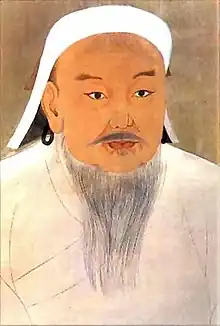
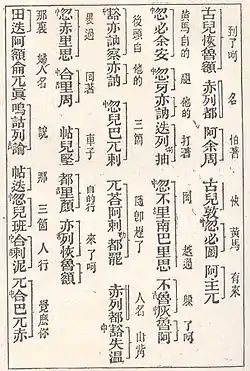
_manuscript_by_Rashid_al-Din_Fazlullah%252C_Iran%252C_early_15th_century_AD%252C_ink%252C_watercolour%252C_and_gold_on_paper_-_Aga_Khan_Museum_-_Toronto%252C_Canada_-_DSC06735.jpg.webp)


.jpeg.webp)
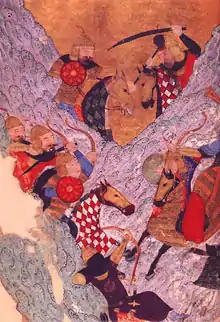
.jpeg.webp)